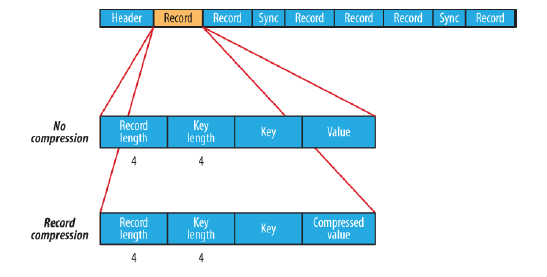Hadoop中sequencefile和mapfile的區別
原文網址:http://blog.csdn.net/javaman_chen/article/details/7241087
Hadoop的HDFS和MapReduce子框架主要是針對大資料檔案來設計的,在小檔案的處理上不但效率低下,而且十分消耗記憶體資源(每一個小檔案佔用一個Block,每一個block的元資料都儲存在namenode的記憶體裡)。解決辦法通常是選擇一個容器,將這些小檔案組織起來統一儲存。HDFS提供了兩種型別的容器,分別是SequenceFile和MapFile。
一、SequenceFile
SequenceFile的儲存類似於Log檔案,所不同的是Log File的每條記錄的是純文字資料,而SequenceFile的每條記錄是可序列化的字元陣列。
SequenceFile可通過如下API來完成新記錄的新增操作:
fileWriter.append(key,value)
可以看到,每條記錄以鍵值對的方式進行組織,但前提是Key和Value需具備序列化和反序列化的功能
Hadoop預定義了一些Key Class和Value Class,他們直接或間接實現了Writable介面,滿足了該功能,包括:
Text 等同於Java中的String
IntWritable 等同於Java中的Int
BooleanWritable 等同於Java中的Boolean
.
.
在儲存結構上,SequenceFile主要由一個Header後跟多條Record組成,如圖所示:

Header主要包含了Key classname,Value classname,儲存壓縮演算法,使用者自定義元資料等資訊,此外,還包含了一些同步標識,用於快速定位到記錄的邊界。
每條Record以鍵值對的方式進行儲存,用來表示它的字元陣列可依次解析成:記錄的長度、Key的長度、Key值和Value值,並且Value值的結構取決於該記錄是否被壓縮。
資料壓縮有利於節省磁碟空間和加快網路傳輸,SeqeunceFile支援兩種格式的資料壓縮,分別是:record compression和block compression。
record compression如上圖所示,是對每條記錄的value進行壓縮
block compression是將一連串的record組織到一起,統一壓縮成一個block,如圖所示:

block資訊主要儲存了:塊所包含的記錄數、每條記錄Key長度的集合、每條記錄Key值的集合、每條記錄Value長度的集合和每條記錄Value值的集合
注:每個block的大小是可通過io.seqfile.compress.blocksize屬性來指定的
示例:SequenceFile讀/寫 操作
- Configuration conf=new Configuration();
- FileSystem fs=FileSystem.get(conf);
- Path seqFile=new Path("seqFile.seq");
- //Reader內部類用於檔案的讀取操作
- SequenceFile.Reader reader=new SequenceFile.Reader(fs,seqFile,conf);
- //Writer內部類用於檔案的寫操作,假設Key和Value都為Text型別
- SequenceFile.Writer writer=new SequenceFile.Writer(fs,conf,seqFile,Text.class,Text.class);
- //通過writer向文件中寫入記錄
- writer.append(new Text("key"),new Text("value"));
- IOUtils.closeStream(writer);//關閉write流
- //通過reader從文件中讀取記錄
- Text key=new Text();
- Text value=new Text();
- while(reader.next(key,value)){
- System.out.println(key);
- System.out.println(value);
- }
- IOUtils.closeStream(reader);//關閉read流
二、MapFile
MapFile是排序後的SequenceFile,通過觀察其目錄結構可以看到MapFile由兩部分組成,分別是data和index。
index作為檔案的資料索引,主要記錄了每個Record的key值,以及該Record在檔案中的偏移位置。在MapFile被訪問的時候,索引檔案會被載入到記憶體,通過索引對映關係可迅速定位到指定Record所在檔案位置,因此,相對SequenceFile而言,MapFile的檢索效率是高效的,缺點是會消耗一部分記憶體來儲存index資料。
需注意的是,MapFile並不會把所有Record都記錄到index中去,預設情況下每隔128條記錄儲存一個索引對映。當然,記錄間隔可人為修改,通過MapFIle.Writer的setIndexInterval()方法,或修改io.map.index.interval屬性;
另外,與SequenceFile不同的是,MapFile的KeyClass一定要實現WritableComparable介面,即Key值是可比較的。
示例:MapFile讀寫操作
- Configuration conf=new Configuration();
- FileSystem fs=FileSystem.get(conf);
- Path mapFile=new Path("mapFile.map");
- //Reader內部類用於檔案的讀取操作
- MapFile.Reader reader=new MapFile.Reader(fs,mapFile.toString(),conf);
- //Writer內部類用於檔案的寫操作,假設Key和Value都為Text型別
- MapFile.Writer writer=new MapFile.Writer(conf,fs,mapFile.toString(),Text.class,Text.class);
- //通過writer向文件中寫入記錄
- writer.append(new Text("key"),new Text("value"));
- IOUtils.closeStream(writer);//關閉write流
- //通過reader從文件中讀取記錄
- Text key=new Text();
- Text value=new Text();
- while(reader.next(key,value)){
- System.out.println(key);
- System.out.println(key);
- }
- IOUtils.closeStream(reader);//關閉read流

注意:使用MapFile或SequenceFile雖然可以解決HDFS中小檔案的儲存問題,但也有一定侷限性,如:
1.檔案不支援複寫操作,不能向已存在的SequenceFile(MapFile)追加儲存記錄
2.當write流不關閉的時候,沒有辦法構造read流。也就是在執行檔案寫操作的時候,該檔案是不可讀取的。
個人理解:
mapfile就是為了解決sequencefile沒有索引的問題而設定的,我們閱讀mapfile的原始碼會發現。
/** A file-based map from keys to values.
*
* <p>A map is a directory containing two files, the <code>data</code> file,
* containing all keys and values in the map, and a smaller <code>index</code>
* file, containing a fraction of the keys. The fraction is determined by
* {@link Writer#getIndexInterval()}.
*
* <p>The index file is read entirely into memory. Thus key implementations
* should try to keep themselves small.
*
* <p>Map files are created by adding entries in-order. To maintain a large
* database, perform updates by copying the previous version of a database and
* merging in a sorted change list, to create a new version of the database in
* a new file. Sorting large change lists can be done with {@link
* SequenceFile.Sorter}.
*/
mapfile包含兩個sequencefile檔案一個儲存資料一個存放索引。索引檔案應該儘量保持比較小,因為操作資料檔案時會把真個索引檔案讀取到記憶體。資料的新增和合並同sequencefile一致。
在來看看 write.append(key,value)
/** Append a key/value pair to the map. The key must be greater or equal
* to the previous key added to the map. */
public synchronized void append(WritableComparable key, Writable val)
throws IOException {
checkKey(key);
long pos = data.getLength();
// Only write an index if we've changed positions. In a block compressed
// file, this means we write an entry at the start of each block
if (size >= lastIndexKeyCount + indexInterval && pos > lastIndexPos) {
position.set(pos); // point to current eof
index.append(key, position);
lastIndexPos = pos;
lastIndexKeyCount = size;
}
data.append(key, val); // append key/value to data
size++;
}
我們可以看到幾個資訊:
①:if條件:size >= lastIndexKeyCount + indexInterval && pos > lastIndexPos,一個條件 key的個數 必須大於 key 上一次寫入索引檔案時key的值 + indexInterval (索引間隔,預設為128),第二個條件 ,寫入位置即當前資料偏移量必須比上次寫入偏移量大。這樣保證了,每隔128個key值寫一次索引檔案。
②:新增的key值必須大於或等於先前的key,使用chek()函式來確定
③:index sequencefile的寫入流 通過 index.append(key, position); 來確定索引檔案的 key和value值,其中 value 是data.getLength()的值,data是通過 FSDataOutputStream輸出流來確定當前資料在整個data檔案中的偏移量。
待續。。。
歡迎朋友們指正。
